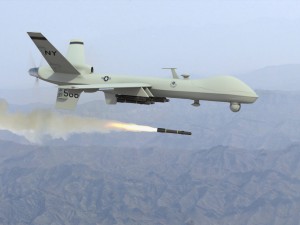The World’s Deadliest Drone: MQ-9 REAPER
MILITARISM, 21 Jan 2013
Antonio C. S. Rosa, editor – TRANSCEND Media Service
– The MQ-9 Reaper (originally the Predator B) is an Unmanned Aerial Vehicle (UAV) also known as a Remotely Piloted Vehicle (RPV)) developed by General Atomics Aeronautical Systems (GA-ASI) for use by the United States Air Force, the United States Navy, Italian Air Force, and the Royal Air Force. The MQ-9 is the first hunter-killer UAV designed for long-endurance, high-altitude surveillance.
– Although the MQ-9 can fly pre-programmed routes autonomously, the aircraft is always monitored or controlled by aircrew in the Ground Control Station and weapons employment is always commanded by the pilot. Hence the preference to refer to the MQ-9 as a Remotely Piloted Vehicle.
– Operators can hunt for targets and observe terrain using a number of sensors, including a thermal camera. One estimate has the on-board camera able to read a license plate from two miles (3.2km) away.
– An operator’s command takes 1.2 seconds to reach the drone via a satellite link.
– An MQ-9 with two 1,000 pound (450 kilogram) external fuel tanks and a thousand pounds of munitions has an endurance of 42 hours. The Reaper has an endurance of 14 hours when fully loaded with munitions.
– The MQ-9 carries a variety of weapons including the GBU-12 Paveway II laser-guided bomb, the AGM-114 Hellfire II air-to-ground missiles, the AIM-9 Sidewinder.[13] and recently, the GBU-38 JDAM (Joint Direct Attack Munition).
For more info CLICK TO SEE Naomi Wolf’s article in The Guardian
This article originally appeared on Transcend Media Service (TMS) on 21 Jan 2013.
Anticopyright: Editorials and articles originated on TMS may be freely reprinted, disseminated, translated and used as background material, provided an acknowledgement and link to the source, TMS: The World’s Deadliest Drone: MQ-9 REAPER, is included. Thank you.
If you enjoyed this article, please donate to TMS to join the growing list of TMS Supporters.

This work is licensed under a CC BY-NC 4.0 License.
